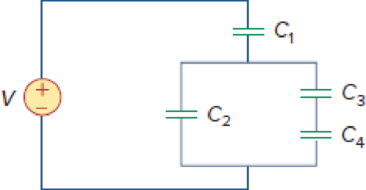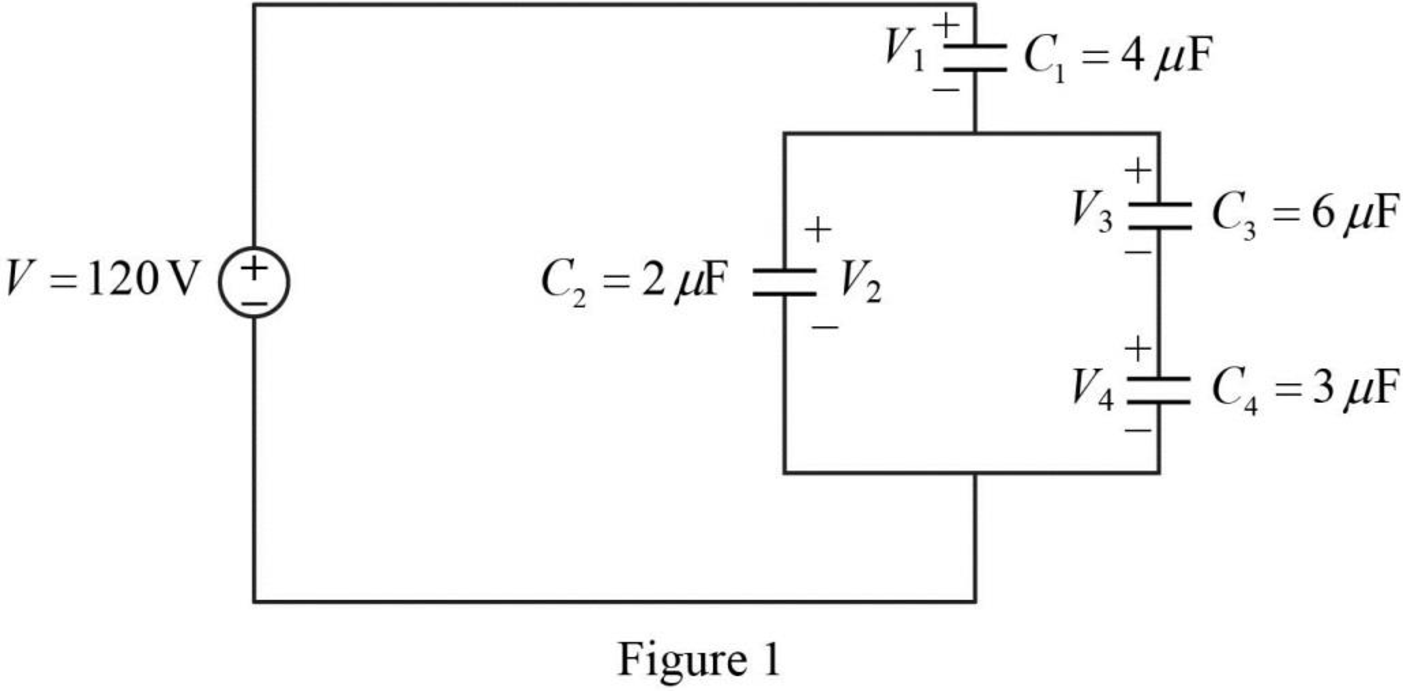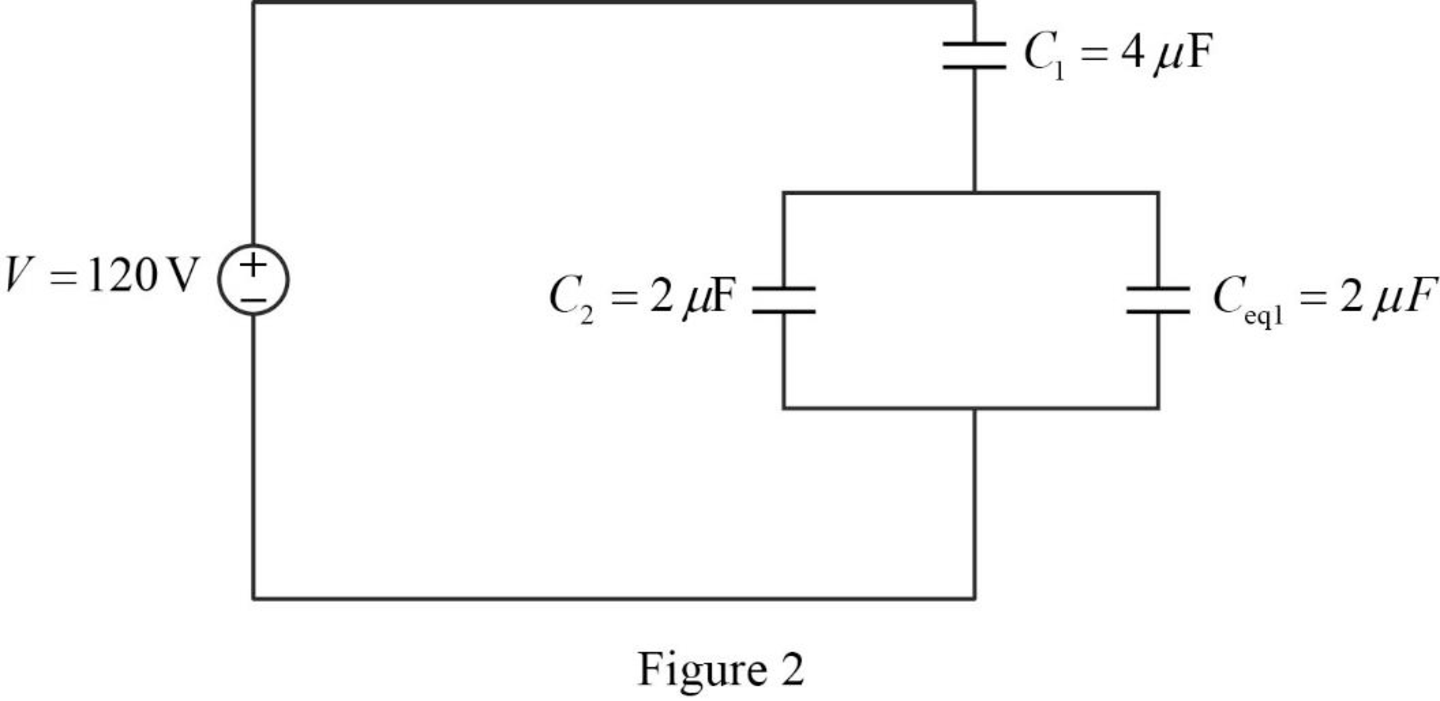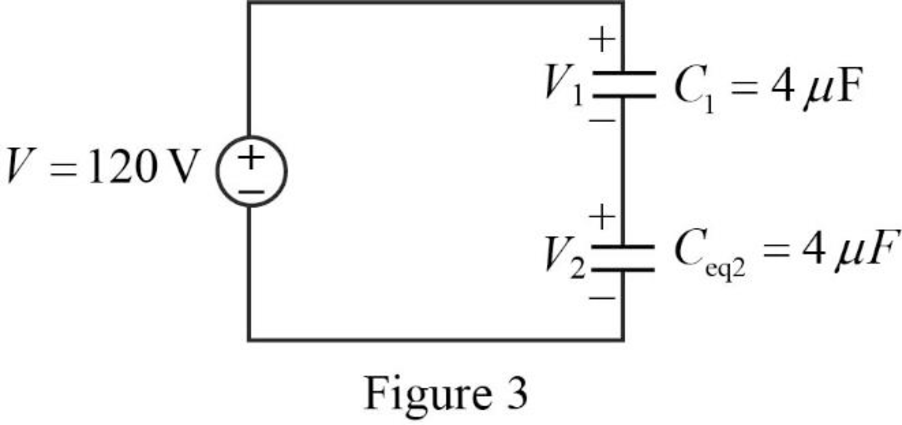
Concept explainers
Using Fig. 6.57, design a problem that will help other students better understand how capacitors work together when connected in series and in parallel.
Figure 6.57

Design a problem to make better understand how capacitors work together when connected in series and in parallel using Figure 6.57.
Explanation of Solution
Problem design:
For the circuit in Figure 6.57, determine the voltage across each capacitor and the energy stored in each capacitor.
Formula used:
Write the expression to calculate the energy stored in the capacitor.
Here,
Calculation:
Refer to Figure 6.57 in the textbook. The Figure 6.57 is redrawn as Figure 1 by assuming the voltage and capacitor values.

Refer to Figure 1, the capacitors
Write the expression to calculate the equivalent capacitance 1 for the series connected capacitors
Here,
Substitute
The reduced circuit of the Figure 1 is drawn as Figure 2.

Refer to Figure 2, the capacitors
Write the expression to calculate the equivalent capacitance 2 for the parallel connected capacitors
Here,
Substitute
The reduced circuit of the Figure 2 is drawn as Figure 3.

Write the expression to calculate the total applied voltage.
Here,
From the Figure 3, it is clear that the voltage across the capacitors with same capacitance value is equal. Therefore,
Substitute
Simplify the above equation to find
Therefore, from equation (5),
Write the expression to calculate the charge across the capacitor 1.
Here,
Substitute
Write the expression to calculate the charge across the capacitor 2.
Substitute
Refer to Figure 2, the capacitors
The combination of the series connected capacitors
Write the expression to calculate the voltage across the capacitor 3.
Substitute
Write the expression to calculate the voltage across the capacitor 4.
Substitute
Re-write the equation (1) to calculate the energy stored in capacitor
Substitute
Re-write the equation (1) to calculate the energy stored in capacitor
Substitute
Re-write the equation (1) to calculate the energy stored in capacitor
Substitute
Re-write the equation (1) to calculate the energy stored in capacitor
Substitute
Therefore, the value of the voltage across the capacitor 1
Conclusion:
Thus, the problem to make better understand how capacitors work together when connected in series and in parallel using Figure 6.57 is designed.
Want to see more full solutions like this?
Chapter 6 Solutions
Fundamentals of Electric Circuits
- PSD A certain signal f(t) has the following PSD (assume 12 load): | Sƒ(w) = π[e¯\w\ + 8(w − 2) + +8(w + 2)] (a) What is the mean power in the bandwidth w≤ 1 rad/sec? (b) What is the mean power in the bandwidth 0.99 to 1.01 rad/sec? (c) What is the mean power in the bandwidth 1.99 to 2.01 rad/sec? (d) What is the total mean power in (t)? Pav= + 2T SfLw) dw - SALW)arrow_forwardAn AM modulation waveform signal:- p(t)=(8+4 cos 1000πt + 4 cos 2000πt) cos 10000nt (a) Sketch the amplitude spectrum of p(t). (b) Find total power, sideband power and power efficiency. (c) Find the average power containing of each sideband.arrow_forwardCan you rewrite the solution because it is unclear? AM (+) = 8(1+ 0.5 cos 1000kt +0.5 ros 2000ks) = cos 10000 πt. 8 cos wat + 4 cos wit + 4 cos Wat coswet. -Jet jooort J11000 t = 4 e jqooort jgoort +4e + e +e j 12000rt. 12000 kt + e +e jooxt igoo t te (w) = 8ES(W- 100007) + 8IS (W-10000) USBarrow_forward
- Can you rewrite the solution because it is unclear? AM (+) = 8(1+0.5 cos 1000kt +0.5 ros 2000 thts) = cos 10000 πt. 8 cos wat + 4 cos wit + 4 cos Wat coswet. J4000 t j11000rt $14+) = 45 jqooort +4e + e + e j 12000rt. 12000 kt + e +e +e Le jsoort -; goon t te +e Dcw> = 885(W- 100007) + 8 IS (W-10000) - USBarrow_forwardCan you rewrite the solution because it is unclear? Q2 AM ①(+) = 8 (1+0.5 cos 1000πt +0.5 ros 2000kt) $4+) = 45 = *cos 10000 πt. 8 cos wat + 4 cosat + 4 cos Wat coswet. j1000016 +4e -j10000πt j11000Rt j gooort -j 9000 πt + e +e j sooort te +e J11000 t + e te j 12000rt. -J12000 kt + с = 8th S(W- 100007) + 8 IS (W-10000) <&(w) = USB -5-5 -4-5-4 b) Pc 2² = 64 PSB = 42 + 4 2 Pt Pc+ PSB = y = Pe c) Puss = PLSB = = 32 4² = 8 w 32+ 8 = × 100% = 140 (1)³×2×2 31 = 20% x 2 = 3w 302 USB 4.5 5 5.6 6 ms Ac = 4 mi = 0.5 mz Ac = 4 ५ M2 = =0.5arrow_forwardA. Draw the waveform for the following binary sequence using Bipolar RZ, Bipolar NRZ, and Manchester code. Data sequence= (00110100) B. In a binary PCM system, the output signal-to-quantization ratio is to be hold to a minimum of 50 dB. If the message is a single tone with fm-5 kHz. Determine: 1) The number of required levels, and the corresponding output signal-to-quantizing noise ratio. 2) Minimum required system bandwidth.arrow_forward
- Find Io using Mesh analysisarrow_forwardFM station of 100 MHz carrier frequency modulated by a 20 kHz sinusoid with an amplitude of 10 volt, so that the peak frequency deviation is 25 kHz determine: 1) The BW of the FM signal. 2) The approximated BW if the modulating signal amplitude is increased to 50 volt. 3) The approximated BW if the modulating signal frequency is increased by 70%. 4) The amplitude of the modulating signal if the BW is 65 kHz.arrow_forwardAn FDM is used to multiplex two groups of signals using AM-SSB, the first group contains 25 speech signals, each has maximum frequency of 4 kHz, the second group contains 15 music signals, each has maximum frequency of 10 kHz. A guard bandwidth of 500 Hz is used bety each two signals and before the first one. 1. Find the BWmultiplexing 2. Find the BWtransmission if the multiplexing signal is modulated using AM-DSB-LC.arrow_forward
- An FM signal with 75 kHz deviation, has an input signal-to-noise ratio of 18 dB, with a modulating frequency of 15 kHz. 1) Find SNRO at demodulator o/p. 2) Find SNRO at demodulator o/p if AM is used with m=0.3. 3) Compare the performance in case 1) and 2).. Hint: for single tone AM-DSB-LC, SNR₁ = (2m²) (4)arrow_forwardFind Va and Vb using Nodal analysisarrow_forwardCalculate the nodal voltage in the circuitarrow_forward
 Delmar's Standard Textbook Of ElectricityElectrical EngineeringISBN:9781337900348Author:Stephen L. HermanPublisher:Cengage Learning
Delmar's Standard Textbook Of ElectricityElectrical EngineeringISBN:9781337900348Author:Stephen L. HermanPublisher:Cengage Learning
